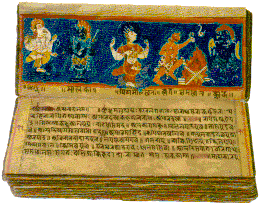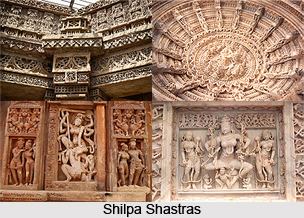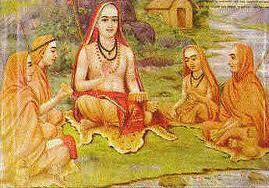 | ||
Similar Vedas, Upanishads, Vedanga, Puranas, Itihasa | ||
What are Shastras? - What is so great about them anyways!?
Shastra (शास्त्र, IAST: Śāstra, [ʃaːst̪rə]) is a Sanskrit word that means "precept, rules, manual, compendium, book or treatise" in a general sense. The word is generally used as a suffix in the Indian literature context, for technical or specialized knowledge in a defined area of practice.
Contents
- What are Shastras What is so great about them anyways
- Etymology
- Chronology and authenticity
- Sutra
- References
Shastra has a similar meaning to English -logy, e.g. ecology, psychology, meaning scientific and basic knowledge on particular subject. Examples in terms of modern neologisms include bhautikashastra "physics", rasayanashastra "chemistry", jīvashastra "biology", vastushastra "architectural science", shilpashastra "science of mechanical arts and sculpture", arthashastra "science of politics, economics" and nitishastra "compendium of ethics or right policy".

In Western literature, Shastra is sometimes spelled as Sastra.
Etymology

"Shastra" commonly refers to a treatise or text on a specific field of knowledge. In early Vedic literature, the word referred to any precept, rule, teaching, ritual instruction or direction. In late and post Vedic literature of Hinduism, Shastra referred to any treatise, book or instrument of teaching, any manual or compendium on any subject in any field of knowledge, including religious. It is often a suffix, added to the subject of the treatise, such as Yoga-Shastra, Nyaya-Shastra, Dharma-Shastra, Koka- or Kama-Shastra, Moksha-Shastra, Artha-Shastra, Alamkara-Shastra (rhetoric), Kavya-Shastra (poetics), Sangita-Shastra (music), Natya-Shastra (theatre & dance) and others.

In Buddhism, a "shastra" is often a commentary written at a later date to explain an earlier scripture or sutra. For example, Yutang Lin says that a text written by him and not given by Buddha, cannot be called a "Sutra"; it is called a "Sastra". In Buddhism, Buddhists are allowed to offer their theses as long as they are consistent with the Sutras, and those are called "Sastras."

In Jainism, the term means the same as in Hinduism. An example of Jaina Shastra is the 12th-century Yoga Shastra of Hemchandracharya.

Shastra is sometimes the root of compounded Sanskrit words. A custodian of Shastra, for example, is called Shashtradhari (Sanskrit: शास्त्रधारी).
Chronology and authenticity
Shastras are predominantly post-Vedic literature, that is after about 500 BCE. However, it is unclear when various Shastras were composed and completed. The authenticity of the manuscripts is also unclear, as many versions of the same text exist, some with major differences. Patrick Olivelle, credited with a 2005 translation of Manu Dharma-sastra, published by the Oxford University Press, states the concerns in postmodern scholarship about the presumed authenticity and reliability of manuscripts as follows (abridged):
The MDh (Manusmriti) was the first Indian legal text introduced to the western world through the translation of Sir William Jones in 1794. (...) All the editions of the MDh, except for Jolly's, reproduce the text as found in the [Calcutta] manuscript containing the commentary of Kulluka. I have called this as the "vulgate version". It was Kulluka's version that has been translated repeatedly: Jones (1794), Burnell (1884), Buhler (1886) and Doniger (1991). (...) The belief in the authenticity of Kulluka's text was openly articulated by Burnell (1884, xxix): "There is then no doubt that the textus receptus, viz., that of Kulluka Bhatta, as adopted in India and by European scholars, is very near on the whole to the original text."
This is far from the truth. Indeed, one of the great surprises of my editorial work has been to discover how few of the over fifty manuscripts that I collated actually follow the vulgate in key readings.
The literature of late 1st millennium BCE such as Arthashastra, and Shastras of various fields of knowledge from the early 1st millennium period is of great interest as it helped the emergence of diverse schools and the spread of Indian religions such as Hinduism and Buddhism in and outside South Asia.
The shastras are both descriptive and prescriptive. Among the various Shastras, Manu's code of law has been among the most studied as the colonial British government attempted to establish different laws in British India based on Sharia for Muslims and Manu's code of law for all non-Muslims.
The shastras are not consistent or a single consensus documents. Dharma-sastras, for example, contain opposing views and contradictory theories. This is in part because they represent an ideal of human behaviour, while at the same time recognising the need to account for likely failings. The shastras do not present life as it was lived. Rather they reveal an idea of what life should be, seen from a Brahmin perspective. The shastra texts constitute one of the great bodies of literature of the ancient world.
Sutra
Sutras are another genre of Indian texts that emerged in the 1st millennium BCE, particularly after the 600 BCE. Sutra (literally "binding thread") denotes a distinct type of literary composition from Shastra. In Sanskrit, "sutra" typically referred to one or more aphorisms; hence sutras use short, aphoristic, evocative statements. In contrast, a Shastra is typically longer, with more detail and explanations. An example of a Sutra is Patanjali's Yogasutras (considered a classic Hindu treatise), while an example of Shastra is Hemachandra's Yogasastra (considered a classic Svetambara Jain treatise), both on yoga.
Shastras and Sutras are among the numerous other genres of literature that has survived from ancient and medieval India. Other genres include Vedas, Upanishads, Vedangas, Itihasa, Puranas, Bhasyas, and Subhashitas.
